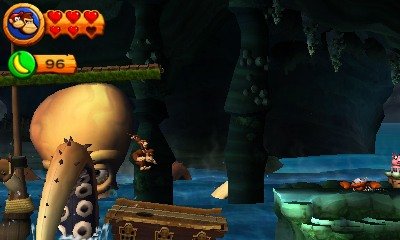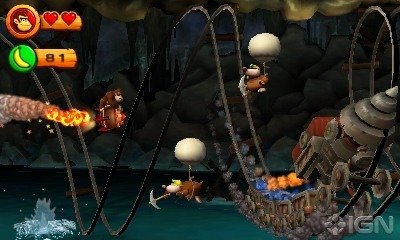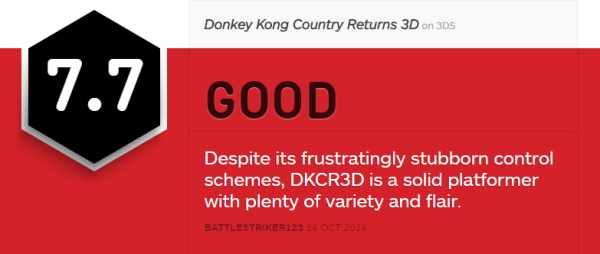Going bananas.
Let me get this out of the way first. Donkey Kong and I do not get along very well. His games are frustratingly demanding, and he moves like a 600-pound rock. Plus, he sort of smells.
Donkey Kong Country Returns does a few things exceptionally well, as you will read later in this review. It is, in my mind, a very competent 2D platformer. There are, however, several aspects of DKCR3D that are certainly worth mentioning, ones that ultimately led to me having a less-than-ideal experience with the game. Part of it is a personal problem – my gaming tastes have solidified in the past several years and my mind refuses to adapt to some newer titles – while others are clearly structural ones engrained within the game itself. Read on to figure out whether this game is right for you.

Donkey Kong is back... again!
First off, Donkey Kong Country Returns 3D is a port of the Wii game of the same name, sans the “3D.” I use the word “port” instead of “remake” because very few things have changed in the three years it took to get the 3DS game out to the masses. DKCR3D adds a few new levels and an “easy mode” for younger players, but apart from that, you are looking at what is essentially the same game repackaged. The game also suffers a bit performance-wise on the not-so-powerful portable; inferior sound design, framerate dips, and obvious visual cutbacks prevent this game from being the definitive version of DKCR. The controls also feel a bit unwieldy on the smaller handheld (even on a 3DS XL), though rolling is now mapped to a shoulder button, thereby eliminating the motion controls that made the Wii version feel a bit uncomfortable.
The controls are really the low-point of DKCR3D. Although the game allows players to choose from several control options, neither felt natural to me. The options do not really make much sense either; one is labeled “Circle Pad” and the other is “Control Pad,” but the two have completely different button layouts. For a game all about tight controls and precise platforming, there really should have been an option to create custom control mappings that fit to each person’s unique playstyle. As a result, my time with DKCR3D felt more like a fight with the game’s controls than actually challenging platforming. Most levels took me well over five minutes to complete because of this, and I found myself unable to play more than two levels per session because of how mentally exhausting it was for me.
I will leave this conversation about DKCR3D’s controls here. If you want to read more about how I feel about video game difficulty, you can read this blog post I wrote not too long ago. It goes into more detail as to why I believe I had a lot of trouble with this game, so if anything I said above concerns you, you might want to check it out. Otherwise, read on.

DKCR3D demands precise platforming.
Despite what I said earlier, DKCR3D is actually still a beautiful game. Most of the visual cutbacks were made in the game’s backgrounds (which can be quite jarring at times), but overall the levels look quite nice. There is a very wide variety of different environments across the game’s eight main worlds, some of which sport very unique visual styles. One of my favorites occurs quite early in the game in a level called “Sunset Shores,” which replaces everything on the stage, including Donkey Kong, with silhouettes, leaving only a glistening orange sunset background and DK’s glowing red tie. The amount of visual variety in DKCR3D is impressive, and everything becomes twice as pretty when the 3D is turned on. Suddenly, what was once a flat surface becomes visually alive, with animals and foliage rummaging around in the foreground and background.
Variety is perhaps DKCR3D’s biggest strength. Although I may have had to fight with the controls for much of the game, I still was to keep on playing for over ten hours total simply because I wanted to see what else the game had to offer. The classic mine cart levels from the old Donkey Kong Country games are back, and new additions like the barrel rocket nicely complement the hectic platforming sections of the main game. Animal buddies like Rambi the Rhinoceros give Donkey Kong and his friends unique abilities, though sometimes they are a bit of a nightmare to control (one level is comprised entirely of Rambi sections, which is easily one of the hardest in the game). I could go on and on about what else DKCR3D has in store, but you will have to discover them yourself. Let me just say that every level has something new to present to the player.

This variety keeps things fresh throughout the game.
DKCR3D is packed to the brim with content. Each of the game’s over 80 levels has a number of collectibles to nag, all of which are used to unlock even more levels in the future. Trying to find some of these extras is exceptionally difficult, many of which are frustratingly “one-and-done” ordeals. There is, optionally, a two-player cooperative mode where one player takes control of Donkey Kong and the other Diddy Kong. While I have not had the chance to try this mode out (it requires two copies of the game to play), it seems like a fun (and helpful) alternative to play the game. The game also has a menu full of extras like images, music (which is phenomenal), dioramas, and movies for your viewing pleasure.
At the end of the day, Donkey Kong Country Returns 3D is a very solid 2D platform game. The controls can be at times difficult to get used to depending on your history with the genre, and there are some inherent problems with the playing the game on a 3DS. Regardless, the amount of variety both in the game’s visuals and its gameplay helps make this game one that fans of the genre should look into. Just be aware of some hiccups down the road.

![Amazing Spider-Man Finale Features New [SPOILER] Costume](../../../../../../assets1.ignimgs.com/2018/06/01/untitled-br-1527892808294_small.jpg)